It’s a good time to be a freelance writer.
The gig economy as a whole is thriving, and outsourced content creation is a big part of that. According to a Content Marketing Institute report, 50% of organizations outsource their content creation.
There’s work out there just waiting to be snatched up! However, the competition has never been tougher. The number of companies looking to pay freelance writers for exceptional work is rising by the day.
Researchers predict that, by 2027, there will be 86.5 million freelancers in the United States. (Making up over 50% of the country’s workforce.) That’s a massive increase from the 4 million freelancers we saw back in 2014.
If you’re struggling to stand out in the crowded market and want to capture more client opportunities, your freelance writer portfolio is a great place to start. But you may be wondering how to create a writing portfolio that attracts new business.
There are five things your writing portfolio should include (plus a bonus) to help you capture the interest of content marketers and earn more jobs now:
- 10-20 Writing Samples
- Intuitive Site Navigation
- Biography
- Links to Social Media
- Call to Action
- BONUS: Recommendations
Let’s dig a bit deeper into these key components and then look at a selection of high-level writing portfolio examples.
What to Put in a Writer Portfolio
There aren’t any hard-and-fast rules when it comes to what you should include in a writing portfolio.
Ultimately, your goal is to make your prospects confident in the fact that you can deliver the work they need to drive business results. But how do you actually do that?
First, ensure you include the following components when creating your online writing portfolio.
1: 10-20 Writing Samples
This one is a bit of a no-brainer, but it is an area where some freelancers trip up. Your portfolio should include enough samples to give brands and marketers a good idea of your range of writing talent and technical expertise.
However, it shouldn’t include too many. Prospective clients should be able to get through your entire portfolio easily without needing to scan through everything you’ve written over the past 10 years.
Finding the balance will depend on your experience and areas of expertise. While 10-20 writing samples are a good average to aim for, don’t lock yourself into a certain number. Be sure your samples showcase:
- Your most recent writing clips
- Industry or niche expertise
2: Intuitive Site Navigation
Speaking of getting through your entire portfolio easily—simple organization and design is critical. Don’t make brands struggle to find the content that’s most relevant to their business. Make your site easy to navigate and optimized for SEO.
A mindful SEO strategy is also important to marketers evaluating your work. SEO will play an increasingly critical role in any freelance writer’s ability to land a content creation job moving forward. At the very least, show that you’ve mastered the art of on-page SEO to help your clients go after their target keywords.
3: Biography
Be sure to provide a brief description of who you are and what you do to set the stage for your writing samples. Keep this section brief, though, and don’t be overly promotional.
If you want to offer more information, link out to a more in-depth “about me” page. At a high level, the biography should tell prospective clients:
- Who you are and where you’re from
- Your professional background and goals
- Relevant professional accomplishments and where you’ve been featured
4: Links to Social Media
Highlight your online presence with links to social media profiles, like LinkedIn and Twitter. As a freelance writer, you’re constantly building your personal brand. Using social media as a way to build up your credibility, authority, and network will give off a greater sense of confidence to potential clients.
When prospects look at your social media profiles, they should learn more about the work that you do. Avoid linking to something like Instagram or Pinterest unless those profiles also serve your freelance writing goals.
5: Call to Action
Let people know how to get in touch with you. Phrasing it as a call-to-action rather than just listing your contact information will help increase the number of conversions your writing portfolio receives.
I’m using marketing terms here deliberately to highlight another skill your portfolio should convey – your grasp of digital marketing techniques. Approach your writing portfolio from a marketer’s POV to show that you are experienced in weaving calls-to-action, buyer personas, and value props into your writing. This is another valuable skill that is quickly becoming a requirement.
BONUS: Recommendations
The secret to success for so many of the top freelance writers? An arsenal of high-value reviews and recommendations is included in their writing portfolios. When you build your portfolio with social proof, you make it easier for prospective clients to trust that you can get the job done.
The reason this point is a bonus is that not every freelance writer is lucky enough to have a variety of client recommendations at their disposal. Start getting in the habit of requesting reviews after a project so you can boost the value of your portfolio.
Writing Portfolio Examples to Influence Yours
We’ve identified all the pieces of the writing portfolio puzzle. Now, how do you put them together to make something that will help you win new gigs?
Your first step might be to look around at some of the more prominent freelance writers and get a feel for what their portfolios look like. That makes sense—no reason you can’t draw inspiration from the successful freelancers who have come before you.
Kaleigh Moore and Elise Dopson provide two examples with somewhat different portfolio styles.
Freelance Writing Portfolio Example #1: Kaleigh Moore
Kaleigh Moore takes a minimalist approach to her portfolio.
She starts with a basic bio that cuts right to the point of why clients hire her. Notice that she offers internal links to the pages that have more in-depth information (for the clients who are considering her services more seriously).
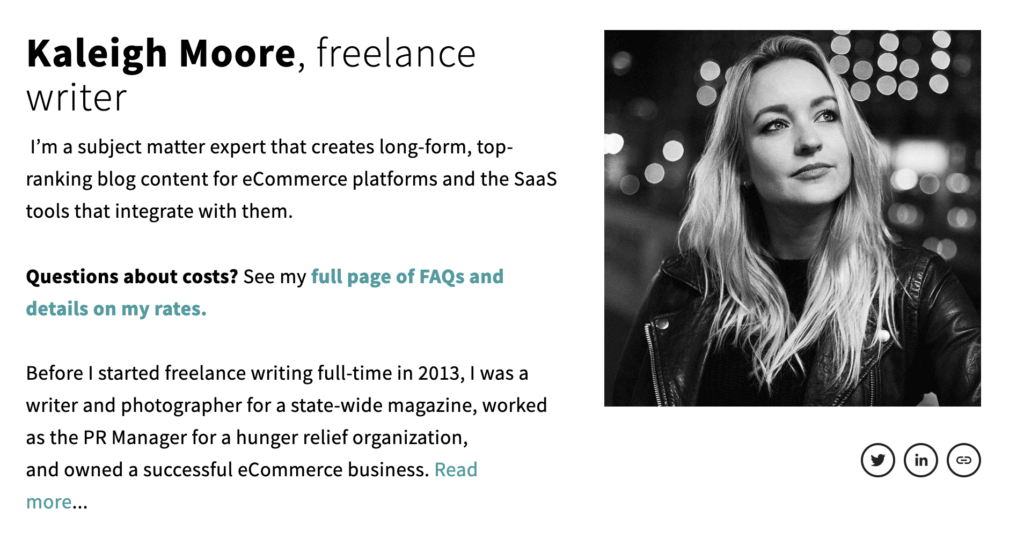
One thing that sets Kaleigh apart from others is that she doesn’t just provide links to client work. She boosts her authority by highlighting her experience training other freelancers to improve their positioning.
The next section is a simple list of client work that captures the range of Kaleigh’s experience. By showing some of the work she’s done for big-name brands, Kaleigh shows prospects who she’s a good fit for while also building credibility. (Note the “Contact Me” button at the bottom that makes it easy to get in touch about new work.)

And lastly, here’s a quick call-out quote from a satisfied client that shows that Kaleigh can get the job done. With HubSpot’s name recognition, Kaleigh knows that this recommendation will carry weight with prospects who view her portfolio.

Freelance Writing Portfolio Example #2: Elise Dopson
Compare Kaleigh Moore’s freelance writer portfolio to Elise Dopson’s, and you’ll notice things are a bit different. Whereas Kaleigh takes the minimalist approach, Elise goes all-in on a results-oriented model.
Her portfolio is still clear and simple, but it highlights far more client relationships to maximize authority.
Right from the start, Elise shows that she has worked with some of the biggest SaaS brands and media sites.

From there, she moves into her featured articles. Anyone in this industry would understand the work it takes to get an article on these sites, giving Elise credibility with ideal clients. (Notice the fact that each section highlights a featured recommendation.)
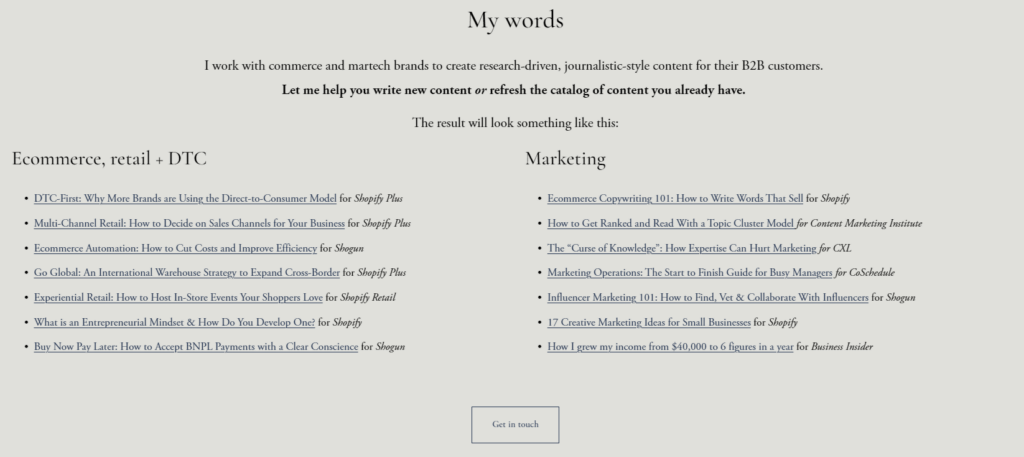
In the next screenshot, you’ll see where the results come in. Rather than just linking to her work, Elise includes screenshots of analytics from an SEO platform. Her section about data-driven blog posts for ConversionXL ties directly to her ability to increase organic keyword rankings.
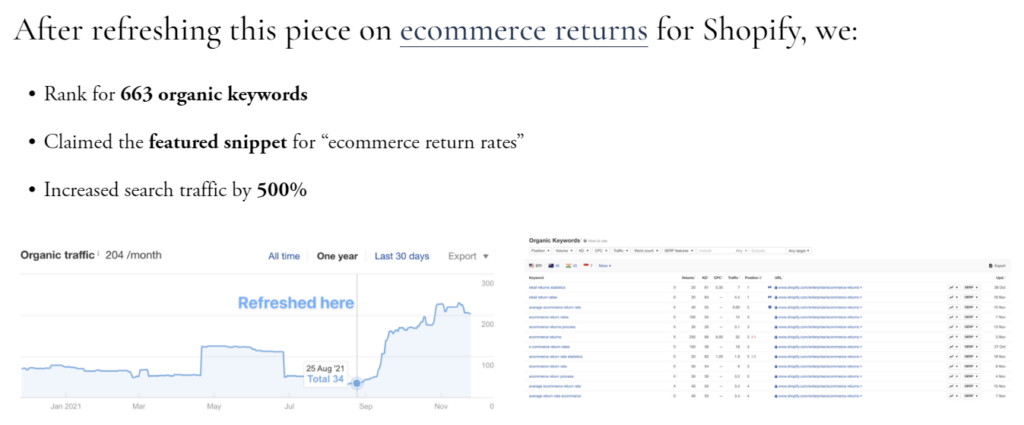
After a few more sections of project highlights and recommendations, Elise ends her portfolio with a clear call to action. Also, notice that she includes her availability in the CTA. This way, there’s no confusion about when she’ll be able to work with new clients (and it has the added bonus of creating a scarcity factor for her services).
How to Build a Writing Portfolio of Your Own
You’ve got your inspiration. You know what to include in the portfolio. All that’s left is to build a writing portfolio all your own.
Maybe you’re not quite ready to set up your own website, though. Maybe you’re doing freelance work on the side rather than in a full-time situation like Kaleigh or Elise. Or, maybe you just want a plug-and-play approach to creating your portfolio and finding work.
The nDash platform contains all the modules you need to cover the key components of an effective freelance writer portfolio.
Step one: Fill in the “Header” Content
Right at the top of your profile, you get a LinkedIn-type headline, the ability to link to any of your social profiles, and a clear CTA button to start a project with you.

Step two: Include Your Biography and Experience
From there, you can build out individual modules for the remaining components of a writing portfolio. This includes your bio and work experience:

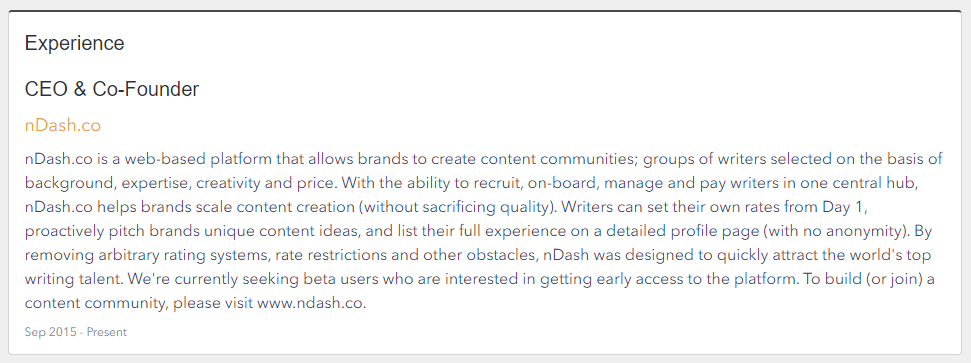
Step three: Add Your Areas of Expertise
Include your areas of expertise, broken down by industry and specified by keywords of your choosing:
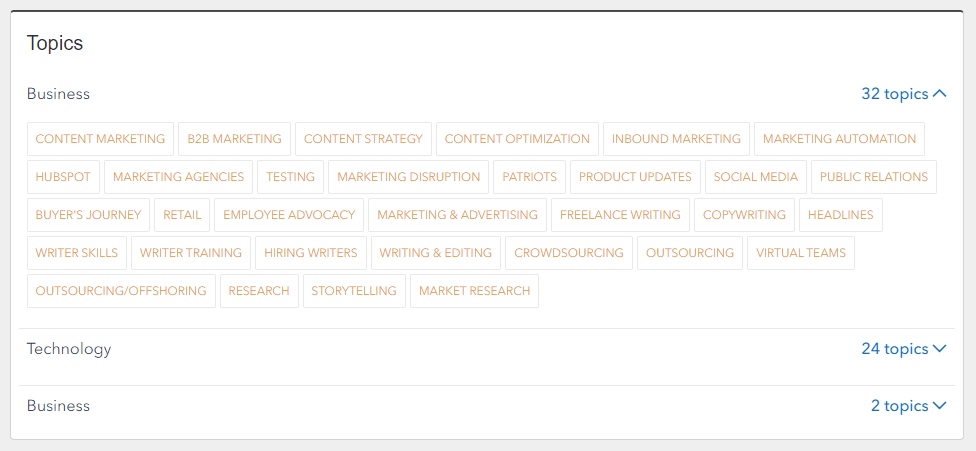
Step four: Add Relevant Writing Samples
You’ll find space for linking to your favorite writing samples, giving clients easy access to the work you want to highlight:
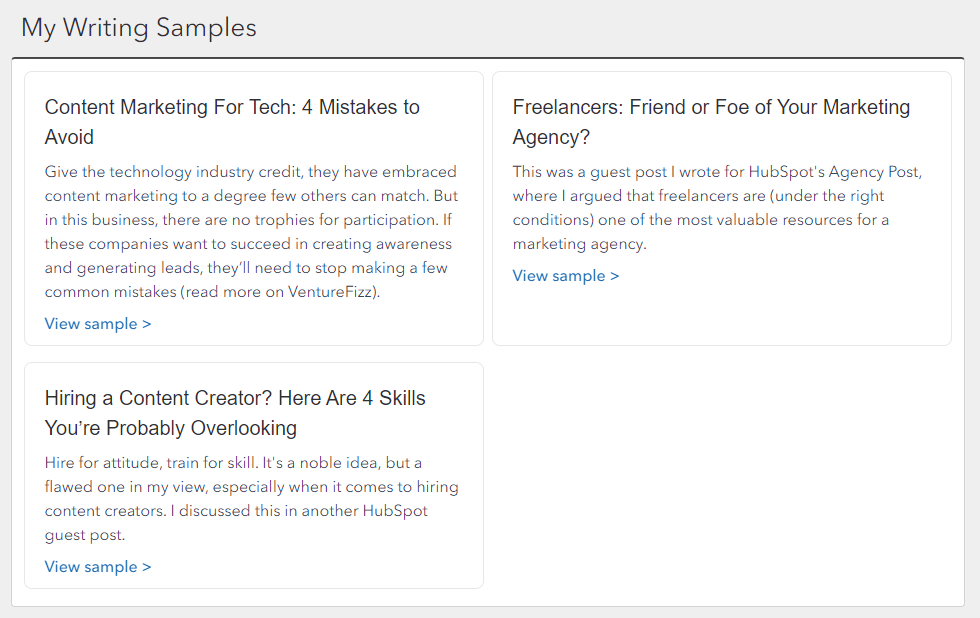
Step five: Request Recommendations
And lastly, there’s a section where you can request client recommendations. When you request client recommendations, they’ll appear in the section here and increase your credibility on nDash.

Create a Writing Portfolio That Wins New Business
Talking about yourself is never a comfortable experience. But in terms of your writer portfolio, it’s a necessary step to increasing revenue and fostering better client relationships.
Filling out all the sections of your nDash portfolio is a step in the right direction. However, your work isn’t done when you’ve optimized your profile. As you continue to win freelance gigs, update your samples with new work to make sure you always put your best foot forward.
And if you ever need help with your profile, reach out and let us know what we can do to help!
Freelance Writer Portfolio FAQs
What should be in a freelance writing portfolio?
Several of your best writing samples, an intuitive layout, a brief biography (don’t be too promotional), links to social media, and a call to action pointing to your email or contact form.
How many pieces of writing should be in a portfolio?
Here’s where you use your best judgment. The recommendation is to have at least ten but no more than 20 writing samples. Ideally, when prospects look at your portfolio they:
- Shouldn’t feel overwhelmed by seeing all the work you’ve completed since the beginning of time
- Should be able to quickly scan through materials showcasing your skills and expertise
Editor’s note: This blog post was originally published in May 2017. It was updated extensively on August 11, 2020, to include new graphics, fresh data, and a more in-depth overview of what to include in a writing portfolio. It was updated again on September 27, 2022, to update data points, update graphics, and expand further on what to include in a writing portfolio.
